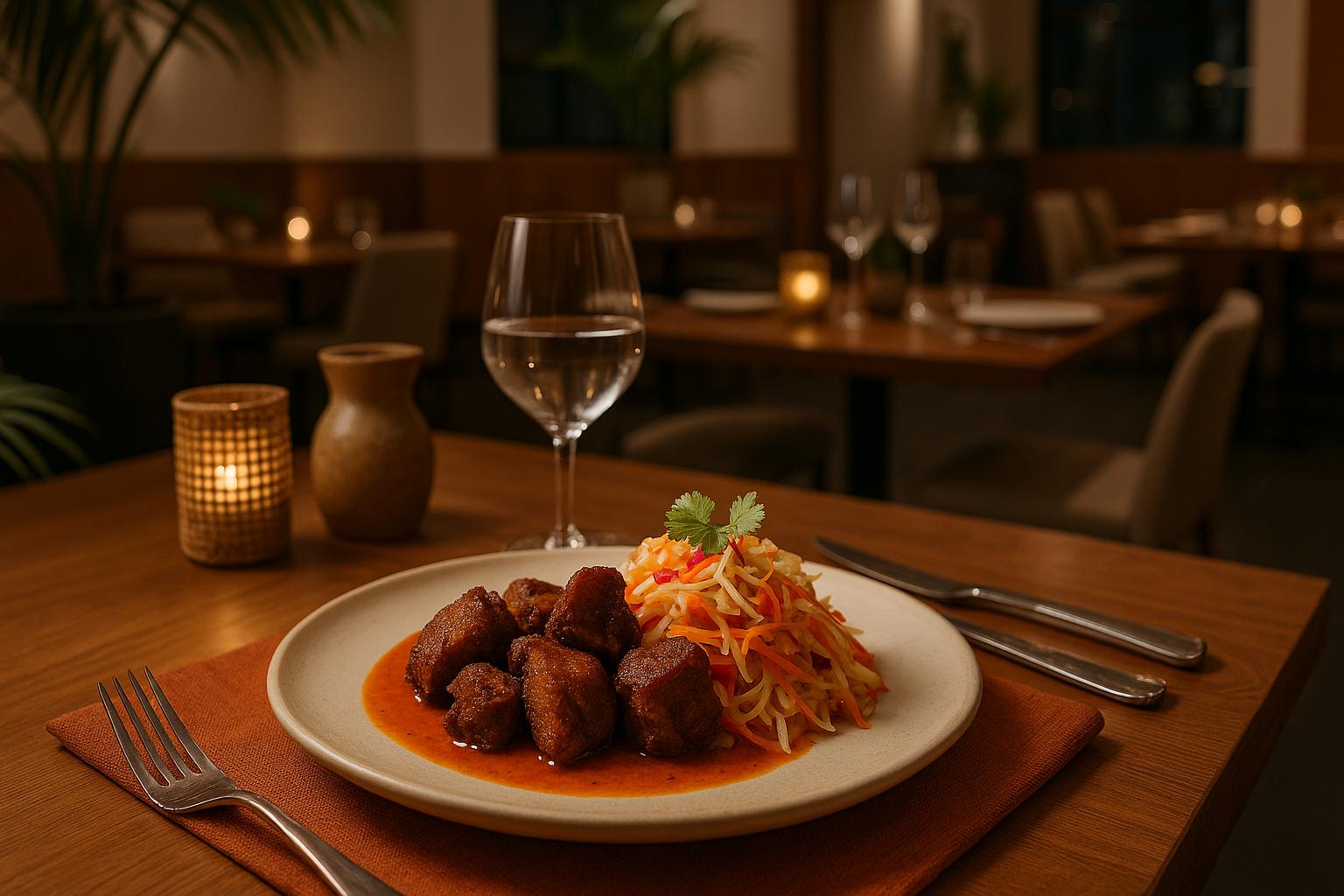Haitian coffee has a 300-year history, once producing half the world's coffee in 1788. Though it now makes up just 0.2% of global coffee production, it’s prized for its smooth, nutty flavor and organic farming methods. Key facts:
- Flavor Profile: Smooth, mellow, with nutty undertones and mild acidity.
- Growing Regions: Central Plateau and Massif du Nord, known for high altitudes and volcanic soil.
- Traditional Brewing: Coffee grounds and sugar are steeped repeatedly for a thick, sweet drink, often paired with bread.
- Challenges: Environmental issues, lack of resources, and damaged infrastructure limit production.
- How to Support: Buy Haitian coffee from direct trade brands like Singing Rooster and Caribbrew, which ensure fair pay for farmers.
Haitian coffee is not just a drink - it’s a connection to a resilient farming heritage. Supporting it helps sustain small-scale farmers and revitalizes a vital industry.
Origins of Haitian Coffee
First Coffee Plants in Haiti
Haiti's coffee story began in 1715 when French colonists introduced coffee plants from Martinique. Under French rule, cultivation expanded rapidly, relying heavily on enslaved labor. By 1788, Haiti had become a major player in the global coffee trade. This early success laid the foundation for Haiti's coffee legacy but also set the stage for significant upheaval.
Effects of the Haitian Revolution
The Haitian Revolution (1791–1801) had a devastating impact on coffee production, slashing output by 45% compared to 1789 levels.
"Damn coffee! Damn colonies!" - Napoleon
After gaining independence, Toussaint Louverture attempted to rebuild the coffee industry. However, setbacks like plantation abandonment following Napoleon's defeat in 1803 made recovery difficult. These events transformed the coffee sector, shifting from large colonial plantations to smaller, family-run farms. The challenges from this period continue to influence Haiti's coffee production today.
Present-Day Growing Challenges
Modern Haitian coffee farmers face numerous obstacles that affect production. The lingering effects of historical disruptions are compounded by more recent events, like the 2010 earthquake, which caused widespread damage. Key challenges include:
- Environmental Struggles: Deforestation and soil erosion threaten coffee-growing regions.
- Economic Constraints: Farmers often lack access to critical resources.
- Damaged Infrastructure: Many farms and processing facilities remain in poor condition.
Even with these difficulties, there is hope. Rising interest in specialty coffee and the growth of fair trade practices are opening new doors for small-scale farmers. While production levels are still far below their historical heights, these developments are helping to gradually rebuild Haiti's coffee industry.
Haiti Traditional Coffee Making
Taste and Growing Areas
Haiti's coffee heritage is deeply intertwined with its distinct flavors and the unique conditions of its growing regions.
Flavor Characteristics
Haitian coffee is known for its smooth, mellow taste with layers of subtle sweetness and complexity. Among its varieties, Haitian Blue coffee stands out as a premium option. Katrina Yentch from Barista Magazine Online highlights its appeal:
"The coffee tasted fantastic, as it was smooth and mellow, yet a pronounced acidity managed to balance it out finely."
This variety has achieved high praise, with one batch earning 92 points on the Coffee Review scale. Its flavor profile typically includes:
| Characteristic | Description |
|---|---|
| Body | Silky, buttery fullness |
| Key Flavor Notes | Distinct nutty undertones |
| Acidity | Mild and balanced |
| Finish | Smooth with a hint of sweetness |
These flavors are a direct result of Haiti's diverse, high-altitude growing areas.
Main Growing Regions
Haiti's coffee thrives in its mountainous terrain, which provides ideal conditions for cultivation. The country has 922 mountainous areas suitable for growing specialty coffee, with Pic la Selle reaching nearly 8,800 feet above sea level. Two key regions are particularly renowned:
- Central Plateau: Known for its rich volcanic soil, consistent rainfall, and a balance of humidity and sunshine.
- Massif du Nord: Features mineral-rich volcanic formations, optimal elevations, and a mix of sun and shade.
These regions primarily grow Typica, Bourbon, and Catimor coffee varieties. Although Haiti's coffee industry represents a small part of the global market, these regions carry forward its rich coffee tradition.
sbb-itb-80c33ff
Haitian Coffee Making Methods
Haitian coffee is brewed into a rich, sweet drink that reflects the island's deep-rooted coffee traditions. This method highlights the cultural significance of coffee in Haiti, as seen in the practices shared by La Colombe Coffee Roasters during their visit to the Association des Paysans Agricoles de Savane-Zombie.
"Hot water was poured through a cloth bag containing coffee grounds and sugar repeatedly to create a strong, sweet, syrupy brew. The coffee was served with dense bread for dipping."
Here's how it's done:
- Place coffee grounds and sugar into a cloth filter.
- Slowly pour hot water over the mixture to saturate it.
- Repeat the process by pouring the liquid through the grounds multiple times.
- Serve the resulting brew with dense bread for dipping.
The result is a thick, flavorful coffee that perfectly embodies the essence of Haitian coffee culture.
Where to Buy Haitian Coffee
Haitian coffee is becoming easier to find in the U.S., thanks to companies that prioritize fair compensation for farmers and high-quality beans. These businesses focus on sourcing directly from Haitian farmers, ensuring both ethical practices and exceptional coffee.
Buying Options
Caribbrew offers an online platform where customers can purchase coffee and participate in a rewards program for frequent buyers. Mokafe Coffee specializes in 100% Arabica beans from southern Haiti, processed using the traditional 'Kafe Pile' method to retain their rich, authentic flavors.
"Mokafe Coffee is a testament to the beauty and greatness of Haiti and Haitian culture. We are passionate about strengthening Haiti's agricultural trade, creating sustainable futures for Haitian coffee farmers, and protecting the island's environment."
Direct Trade Benefits
Ethical sourcing through direct trade does more than bring great coffee to your cup - it directly supports Haitian farmers. Singing Rooster, for example, pays farmers a minimum of $4 per pound, which is nearly double the standard Fair Trade rate. Additionally, they return 50 cents per pound for business development.
Here’s how the financial benefits break down:
- Farmers receive 66% of the revenue from each bag sold.
- Community earnings rise to 77% when proceeds are reinvested locally.
- This is crucial in a country where the average farming family earns less than $800 annually.
"Farmers, not middlemen, will transform Haiti", says Molly Nicaise, co-founder and CEO of Singing Rooster. "We're building rural economies because farmers, not middlemen, spend money at home."
Impact of Coffee Purchases
Buying Haitian coffee through direct trade channels supports more than just the coffee industry. Organizations like Singing Rooster reinvest all proceeds into farming communities, funding:
- Agricultural training
- Business education
- Pre-harvest financing
- Processing facilities
- Entrepreneurial initiatives
These efforts improve coffee quality and preserve Haiti’s rich coffee heritage. By choosing brands that prioritize direct relationships with farmers and responsible practices, consumers play a role in securing the future of Haiti's coffee industry.
Conclusion
Main Takeaways
In 1788, Haiti supplied half of the world's coffee. Today, it accounts for just 0.2%, yet its coffee is still recognized for its exceptional quality. Known for its smooth, low-acid flavor and grown organically in mountainous regions, Haitian coffee stands out in specialty markets. This contrast between Haiti's past and present highlights its evolving place in the global coffee industry.
Supporting Haiti's Coffee
Consumers play a key role in revitalizing Haitian coffee farming, building on the success of direct trade. Fair trade initiatives and specialty markets allow farmers to earn higher prices for their coffee. This support benefits Haiti's agricultural community, which made up 66% of the population in the 1980s.
Here’s how you can help:
- Purchase origin-labeled Haitian coffee to ensure authenticity.
- Choose fair trade and organic certified options to support ethical practices.
- Encourage direct trade partnerships for stronger farmer-to-market connections.
FAQs
What impact did the Haitian Revolution have on Haiti's coffee industry, and how did it change afterward?
The Haitian Revolution, which began in 1791, had a profound effect on Haiti's coffee industry. Before the revolution, Haiti (then called Saint-Domingue) was the world's largest coffee producer, supplying about half of the global market by the late 18th century. However, the conflict led to widespread destruction of coffee plantations, significantly reducing production.
In the years following independence in 1804, efforts were made to rebuild the coffee industry, but Haiti never regained its dominant position in the global market. Nonetheless, coffee remains an important part of Haitian culture and economy, with small-scale farmers continuing to grow coffee using traditional methods.
What challenges do Haitian coffee farmers face today, and how are they being supported?
Haitian coffee farmers face several challenges, including deforestation, soil erosion, and the effects of political and economic instability. These issues are compounded by the historical collapse of international coffee agreements, which disrupted global trade, and past trade embargoes that limited export opportunities.
To address these challenges, initiatives like the Kafe Tyòt se Richès (KTSR) project, supported by USAID, are helping farmers by providing training, high-quality seedlings, and better access to both local and export markets. Additionally, organizations such as Café Kreyol and Singing Rooster work directly with farmers to improve coffee quality, promote sustainable practices, and ensure fair wages. These efforts aim to boost productivity and create a more stable future for Haiti’s coffee industry.
How does direct trade benefit Haitian coffee farmers and their communities?
Direct trade provides Haitian coffee farmers with better financial opportunities by allowing them to sell their coffee at higher prices, bypassing middlemen. This ensures that more of the profit goes directly to the farmers, helping to improve their quality of life and invest in their communities.
By supporting direct trade, consumers also foster sustainable farming practices and help preserve the rich cultural and historical significance of Haitian coffee. These partnerships empower small-scale farmers and contribute to the revival of Haiti's coffee industry, making a meaningful impact on both local economies and global coffee culture.


